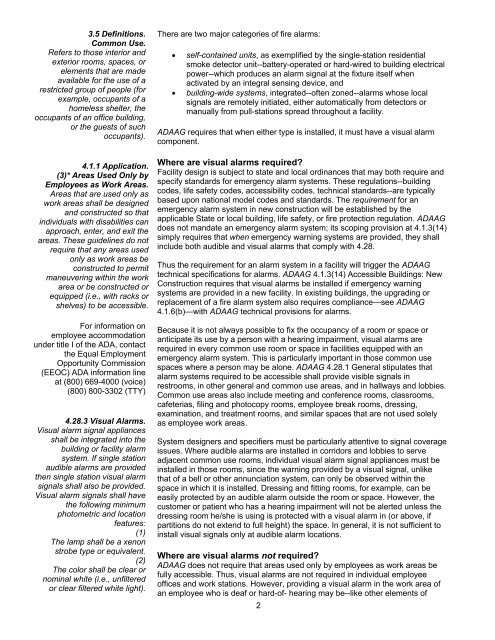Fire Protection Design Manual - Office of Construction and Facilities ...
Fire Protection Design Manual - Office of Construction and Facilities ...
Fire Protection Design Manual - Office of Construction and Facilities ...
You also want an ePaper? Increase the reach of your titles
YUMPU automatically turns print PDFs into web optimized ePapers that Google loves.
3.5 Definitions.<br />
Common Use.<br />
Refers to those interior <strong>and</strong><br />
exterior rooms, spaces, or<br />
elements that are made<br />
available for the use <strong>of</strong> a<br />
restricted group <strong>of</strong> people (for<br />
example, occupants <strong>of</strong> a<br />
homeless shelter, the<br />
occupants <strong>of</strong> an <strong>of</strong>fice building,<br />
or the guests <strong>of</strong> such<br />
occupants).<br />
4.1.1 Application.<br />
(3)* Areas Used Only by<br />
Employees as Work Areas.<br />
Areas that are used only as<br />
work areas shall be designed<br />
<strong>and</strong> constructed so that<br />
individuals with disabilities can<br />
approach, enter, <strong>and</strong> exit the<br />
areas. These guidelines do not<br />
require that any areas used<br />
only as work areas be<br />
constructed to permit<br />
maneuvering within the work<br />
area or be constructed or<br />
equipped (i.e., with racks or<br />
shelves) to be accessible.<br />
For information on<br />
employee accommodation<br />
under title I <strong>of</strong> the ADA, contact<br />
the Equal Employment<br />
Opportunity Commission<br />
(EEOC) ADA information line<br />
at (800) 669-4000 (voice)<br />
(800) 800-3302 (TTY)<br />
4.28.3 Visual Alarms.<br />
Visual alarm signal appliances<br />
shall be integrated into the<br />
building or facility alarm<br />
system. If single station<br />
audible alarms are provided<br />
then single station visual alarm<br />
signals shall also be provided.<br />
Visual alarm signals shall have<br />
the following minimum<br />
photometric <strong>and</strong> location<br />
features:<br />
(1)<br />
The lamp shall be a xenon<br />
strobe type or equivalent.<br />
(2)<br />
The color shall be clear or<br />
nominal white (i.e., unfiltered<br />
or clear filtered white light).<br />
There are two major categories <strong>of</strong> fire alarms:<br />
• self-contained units, as exemplified by the single-station residential<br />
smoke detector unit--battery-operated or hard-wired to building electrical<br />
power--which produces an alarm signal at the fixture itself when<br />
activated by an integral sensing device, <strong>and</strong><br />
• building-wide systems, integrated--<strong>of</strong>ten zoned--alarms whose local<br />
signals are remotely initiated, either automatically from detectors or<br />
manually from pull-stations spread throughout a facility.<br />
ADAAG requires that when either type is installed, it must have a visual alarm<br />
component.<br />
Where are visual alarms required?<br />
Facility design is subject to state <strong>and</strong> local ordinances that may both require <strong>and</strong><br />
specify st<strong>and</strong>ards for emergency alarm systems. These regulations--building<br />
codes, life safety codes, accessibility codes, technical st<strong>and</strong>ards--are typically<br />
based upon national model codes <strong>and</strong> st<strong>and</strong>ards. The requirement for an<br />
emergency alarm system in new construction will be established by the<br />
applicable State or local building, life safety, or fire protection regulation. ADAAG<br />
does not m<strong>and</strong>ate an emergency alarm system; its scoping provision at 4.1.3(14)<br />
simply requires that when emergency warning systems are provided, they shall<br />
include both audible <strong>and</strong> visual alarms that comply with 4.28.<br />
Thus the requirement for an alarm system in a facility will trigger the ADAAG<br />
technical specifications for alarms. ADAAG 4.1.3(14) Accessible Buildings: New<br />
<strong>Construction</strong> requires that visual alarms be installed if emergency warning<br />
systems are provided in a new facility. In existing buildings, the upgrading or<br />
replacement <strong>of</strong> a fire alarm system also requires compliance—see ADAAG<br />
4.1.6(b)—with ADAAG technical provisions for alarms.<br />
Because it is not always possible to fix the occupancy <strong>of</strong> a room or space or<br />
anticipate its use by a person with a hearing impairment, visual alarms are<br />
required in every common use room or space in facilities equipped with an<br />
emergency alarm system. This is particularly important in those common use<br />
spaces where a person may be alone. ADAAG 4.28.1 General stipulates that<br />
alarm systems required to be accessible shall provide visible signals in<br />
restrooms, in other general <strong>and</strong> common use areas, <strong>and</strong> in hallways <strong>and</strong> lobbies.<br />
Common use areas also include meeting <strong>and</strong> conference rooms, classrooms,<br />
cafeterias, filing <strong>and</strong> photocopy rooms, employee break rooms, dressing,<br />
examination, <strong>and</strong> treatment rooms, <strong>and</strong> similar spaces that are not used solely<br />
as employee work areas.<br />
System designers <strong>and</strong> specifiers must be particularly attentive to signal coverage<br />
issues. Where audible alarms are installed in corridors <strong>and</strong> lobbies to serve<br />
adjacent common use rooms, individual visual alarm signal appliances must be<br />
installed in those rooms, since the warning provided by a visual signal, unlike<br />
that <strong>of</strong> a bell or other annunciation system, can only be observed within the<br />
space in which it is installed. Dressing <strong>and</strong> fitting rooms, for example, can be<br />
easily protected by an audible alarm outside the room or space. However, the<br />
customer or patient who has a hearing impairment will not be alerted unless the<br />
dressing room he/she is using is protected with a visual alarm in (or above, if<br />
partitions do not extend to full height) the space. In general, it is not sufficient to<br />
install visual signals only at audible alarm locations.<br />
Where are visual alarms not required?<br />
ADAAG does not require that areas used only by employees as work areas be<br />
fully accessible. Thus, visual alarms are not required in individual employee<br />
<strong>of</strong>fices <strong>and</strong> work stations. However, providing a visual alarm in the work area <strong>of</strong><br />
an employee who is deaf or hard-<strong>of</strong>- hearing may be--like other elements <strong>of</strong><br />
2

















